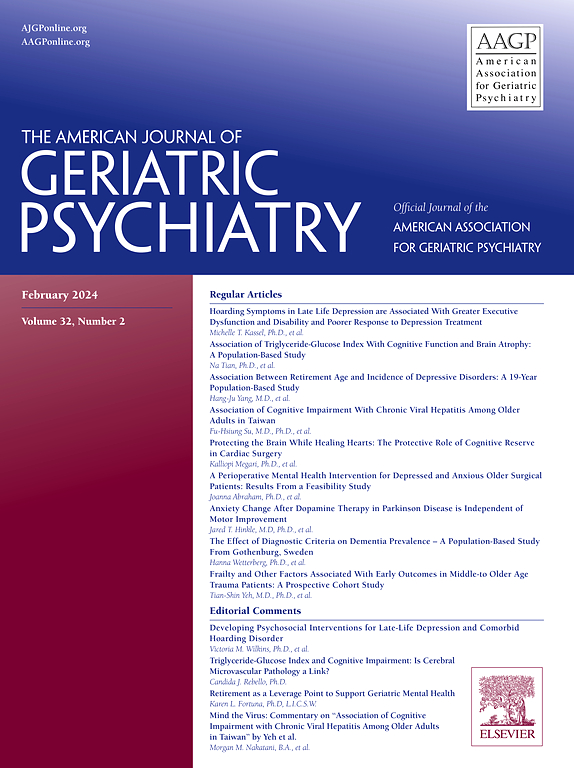9. 帕金森病患者社会隔离和孤独感的心理保健策略
IF 3.8
2区 医学
Q1 GERIATRICS & GERONTOLOGY
引用次数: 0
摘要
帕金森病(PD)的症状,包括情绪和沟通障碍,会损害社会功能。社会隔离和孤独与PD患者的症状严重程度和生活质量下降有关。我们的目标是强调提供者的干预措施,以改善PD患者的社会隔离和孤独感。方法对PD患者孤独感和社会情绪症状的临床研究、倡导项目和相关立法工作进行综合文献和政策回顾。结果:越来越多的人关注识别和减轻PD患者的孤独感,专家们提出了一些建议,包括提高认识、常规筛查和有针对性的干预措施。在这些干预措施中,社会处方——一种通过基于社区的干预措施解决患者社会需求的系统方法——受到了关注。然而,支持社会处方的现有证据主要来自单一付款人医疗保健系统,在美国医疗保健支付模式背景下调查其有效性的研究有限。此外,文献强调,不仅要提高PD患者对孤独感的认识,还要提高对更广泛的社会情绪症状的认识,如情绪面部表情、情绪识别和声音表达方面的困难。结论医护人员应优先筛查和识别PD患者的孤独感和社会情绪症状。建议包括患者和护理人员教育、声乐和呼吸练习(如集体歌唱)、心理干预(如正念、ACT、CBT)和社会处方,如退伍军人事务部同情联系团计划。提供者可以通过提倡政策来扩大他们的影响范围,包括PD护理同伴的报销。本文章由计算机程序翻译,如有差异,请以英文原文为准。
9. MENTAL HEALTHCARE STRATEGIES FOR SOCIAL ISOLATION AND LONELINESS IN PARKINSON’S DISEASE
Introduction
Parkinson's disease (PD) symptoms, including emotional and communication challenges, can impair social functioning. Social isolation and loneliness have been linked to greater symptom severity and reduced quality of life in individuals with PD. We aim to highlight interventions by providers to improve social isolation and loneliness in patients with PD.
Methods
A comprehensive literature and policy review was conducted, examining clinical research, advocacy projects, and relevant legislative efforts focused on addressing loneliness and socioemotional symptoms in PD.
Results
The growing focus on recognizing and mitigating loneliness in PD has led to recommendations from experts, including the need for heightened awareness, routine screening, and targeted interventions. Among these interventions, social prescribing—a systematic approach addressing patients' social needs via community-based interventions—has gained attention. However, existing evidence supporting social prescribing primarily stems from single-payer healthcare systems, with limited research investigating its effectiveness in the context of U.S. healthcare payment models. Furthermore, literature highlights the importance of enhancing awareness not only of loneliness in PD but also of broader socio-emotional symptoms, such as difficulties with emotional facial expressions, emotional recognition, and vocal expressions.
Conclusions
Healthcare providers should prioritize screening and identification of loneliness and socioemotional symptoms in PD. Recommendations include patient and caregiver education, vocal and respiratory exercises (e.g., group singing), psychological interventions (e.g. mindfulness, ACT, CBT), and social prescribing, such as the VA Compassionate Contact Corps Program. Providers may widen their reach by advocating for policies, including reimbursement for care companions in PD.
求助全文
通过发布文献求助,成功后即可免费获取论文全文。
去求助
来源期刊
CiteScore
13.00
自引率
4.20%
发文量
381
审稿时长
26 days
期刊介绍:
The American Journal of Geriatric Psychiatry is the leading source of information in the rapidly evolving field of geriatric psychiatry. This esteemed journal features peer-reviewed articles covering topics such as the diagnosis and classification of psychiatric disorders in older adults, epidemiological and biological correlates of mental health in the elderly, and psychopharmacology and other somatic treatments. Published twelve times a year, the journal serves as an authoritative resource for professionals in the field.

 求助内容:
求助内容: 应助结果提醒方式:
应助结果提醒方式:


